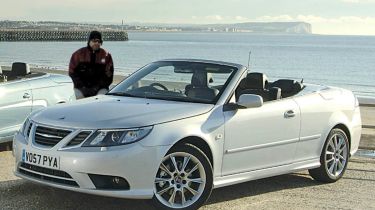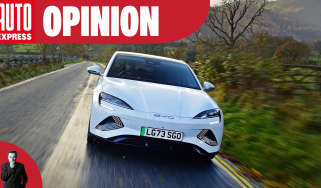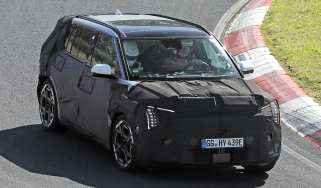Saab 9-3 Conv. Linear SE
Saab has plenty of experience at building convertibles, but is the 9-3 enough to keep ahead of the Eos?
There’s no doubt that Saab has a more prestigious image than Volkswagen. But is its drop-top contender better looking? Style is crucial to the appeal of any cabrio, but we don’t think the 9-3 is as fresh or interesting as the Eos.
It looks OK with the hood up, but the bulky fabric means the
9-3 has a smaller glass area and darker cabin than the Eos, and generally appears a bit more old-fashioned. It’s far more successful with the hood lowered. The Swedish car’s elegant, flowing side profile makes it clear that it was designed as a model in its own right from the outset.
The major styling changes for the revamped 9-3 are found at the front, where Saab has introduced a new face inspired by the Aero X concept model. There are revised headlamp lenses, which feature a narrow band of LED running lights across the top. The side of the car has been cleaned up, too, as Saab has colour-coded
all the running strips, while the tail has also been tidied.
Lowering the 9-3’s hydraulically-powered triple-layer hood is a straightforward operation. There are no catches or levers to release; simply press a button on the dashboard, and the
top folds out of sight.
Not only is the operation a lot quicker than on the Eos, with the Saab taking 23.5 seconds compared to 32.5 seconds for the VW, but the 9-3’s hood can also be used at up to 20mph – the Eos’ can only be operated if the car is stationary. When it comes to keeping warm on winter days, the Saab is a better place to be than the VW. With the hood down, the 9-3’s cabin is noisier than the Eos’, but less blustery, and it holds the heat in better, too.
There’s also a lot more room in the Saab. Whether the roof is up or down, the 9-3 provides more space for its occupants, especially those sitting in the back. But it’s not all good news. A new interior
was introduced last year, but the plastics aren’t in the same league as the VW’s, and although there are some neat touches which add character to the cabin – such as Saab’s traditional
ignition key position on the tunnel – overall fit and finish
are not what they should be.
Saab has revised the 9-3’s front-wheel-drive chassis, and
as a result there’s less body shake than before – although
it’s not nearly as robust and solid as its German rival.
There’s still a slight tendency for the front wheels to follow
cambers and ruts under hard acceleration, while on wet roads the traction control light flickers frequently. What’s more, you have to pay an extra £350 if you want electronic stability control – it’s standard on the VW. Overall the revisions have improved the
handling slightly, and on smooth flowing roads the 9-3 is pleasant enough to drive. But it’s a long way from sporting and doesn’t offer the composure or involvement of the more sophisticated VW.
It does have the edge for power, though, with 150bhp compared to 138bhp. Both produce an identical 320Nm of torque, but
as the Saab is much heavier – it weighs 1,755kg – it isn’t as
fast as the lighter Eos.
Power delivery is a bit sudden, yet the engine is less intrusive when the roof is down. A slightly notchy gearshift and an awkward, long-travel clutch blot the 9-3’s copybook, although its brakes are stronger than the VW’s.
Saab has plenty of experience at building convertibles, but is the 9-3 enough of an all-rounder to keep ahead of the Eos?
Details
Price: £26,430
Model tested: Saab 9-3 Linear 1.9 TiD SE
Chart position: 2
WHY: Saab has revamped its roomy four-seater drop-top with a new nose and updated suspension.
Economy
Saab claims 44.8mpg for the 1.9 TiD 9-3, but during our test it returned 36.1mpg. Fuel for 12,000 miles will cost £1,603, but the VW will go that distance for £185 less.
Residuals
Judged by normal standards, a residual value of 46.2 per cent doesn’t sound too bad. But compared to other drop-tops, it’s disappointing, meaning the 9-3 loses £14,219 over three years.
Servicing
With the first three services costing £320, £420 and £320, no wonder the 9-3 has such high running costs (67.2 pence per mile). That’s £455 more than for the VW.
Tax
The Saab engine produces 169g/km of CO2, placing it in tax band E, while the cleaner 158g/km VW sits one group lower in band D. A year’s road tax for the Saab costs £165; the VW is £140.



